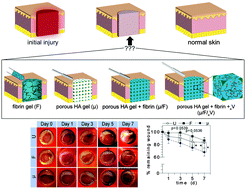Systematic evaluation of natural scaffolds in cutaneous wound healing†
Abstract
Current strategies to improve wound healing are often created from multiple components that may include a scaffold, cells, and bioactive cues. Acellular natural hydrogels are an attractive approach since the material's intrinsic biological activity can be paired with mechanical properties similar to soft tissue to induce a host's response toward healing. In this report, a systematic evaluation was conducted to study the effect of hydrogel scaffold implantation in skin healing using a human-relevant murine wound healing model. Fibrin, microporous hyaluronic acid, and composite hydrogels were utilized to study the effect of conductive scaffolds on the wound healing process. Composite hydrogels were paired with plasmin-degradable VEGF nanocapsules to investigate its impact as an inductive composite hydrogel on tissue repair. By 7 days, wound healing and vessel maturation within the newly formed tissue was significantly improved by the inclusion of porous scaffold architecture and VEGF nanocapsules.

- This article is part of the themed collection: Bio-inspired and natural materials

 Please wait while we load your content...
Please wait while we load your content...